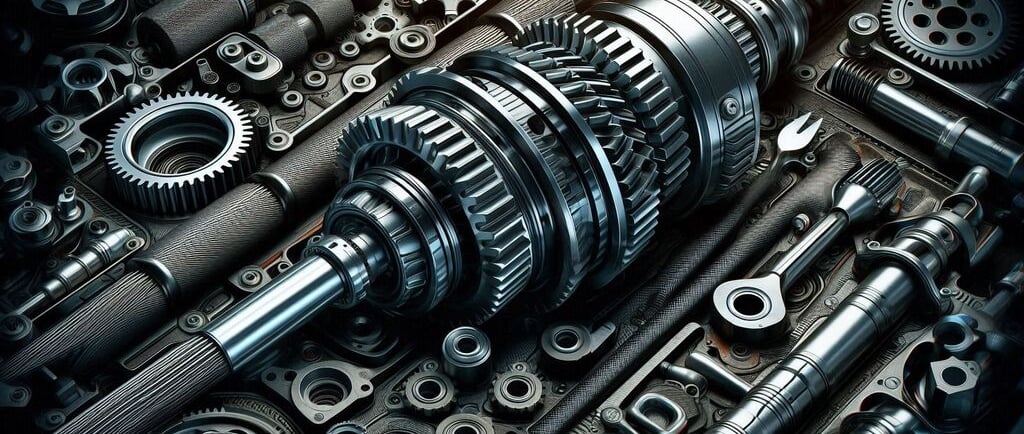Driveshaft: Transmits power from the transmission to the wheels.
When you step on the gas pedal of your vehicle, you’re activating a series of components that work together to move your car forward.
TRANSMISSION COMPONENTS
11/12/20244 min read


Driveshaft: Transmits Power from the Transmission to the Wheels
When you step on the gas pedal of your vehicle, you’re activating a series of components that work together to move your car forward. One of the essential components in this process is the driveshaft. Without it, your car’s power would remain trapped in the engine and transmission, unable to reach the wheels. In this article, we’ll explore what a driveshaft is, how it functions, and why it’s so important for your vehicle’s performance.
What is a Driveshaft?
A driveshaft is a long, rotating shaft that transmits power from the transmission to the wheels of your vehicle. It is an integral part of the drivetrain system, which includes all components responsible for delivering power from the engine to the wheels. The driveshaft is typically found in rear-wheel drive (RWD) and all-wheel drive (AWD) vehicles, but front-wheel drive (FWD) vehicles use a different system involving axles and CV joints.
Key Components of a Driveshaft
Universal Joints (U-joints): These joints allow the driveshaft to flex and adapt to the movement of the suspension while transmitting power. They are crucial for maintaining smooth rotation as the driveshaft moves.
Slip Yoke: This part connects the driveshaft to the transmission and allows for movement in length to accommodate suspension travel.
Center Bearings: On longer driveshafts, center bearings are used to support the shaft and keep it stable during operation.
Flange or U-joint Yoke: These connect the driveshaft to the differential or axle.
How Does the Driveshaft Work?
The primary function of the driveshaft is to transmit power from the vehicle’s transmission to the wheels, converting the engine's energy into motion. Here’s how it works:
Power from the Engine: When the engine runs, it produces torque. The transmission takes this torque and adjusts it, depending on the gear you’re in.
Transmitting Power to the Driveshaft: The transmission then sends the adjusted torque to the driveshaft, typically through the U-joint. The driveshaft rotates to transmit this energy to the rear or front axle, depending on the vehicle's drivetrain layout.
Power to the Wheels: Once the torque reaches the differential or axle, it is sent to the wheels, allowing the vehicle to move.
This constant flow of energy is essential for your car’s movement, and any disruption in the system can lead to mechanical issues or a complete loss of power delivery to the wheels.
Types of Driveshafts
There are different types of driveshafts based on the vehicle's configuration:
Single-piece Driveshaft: Most commonly used in vehicles with rear-wheel drive or all-wheel drive. It’s a simple, single shaft that transfers power efficiently.
Multi-piece Driveshaft: Found in longer vehicles, such as trucks, where a single driveshaft would be too long to operate efficiently. These driveshafts are made up of two or more sections connected by joints.
Carbon Fiber Driveshaft: A lighter, high-performance alternative to steel driveshafts, often used in sports cars to reduce weight without sacrificing strength.
Common Problems with Driveshafts
Driveshafts are built to last, but like any other vehicle component, they can wear out or become damaged over time. Below are a few common issues that can occur with driveshafts:
Vibration: One of the most noticeable signs of driveshaft issues is vibration while driving. This could be caused by a damaged U-joint or an unbalanced driveshaft. If left unchecked, it can lead to further damage to the drivetrain components.
Unusual Noises: If you hear a clunking or grinding noise, especially when shifting gears or during acceleration, it could be a sign that the driveshaft or its components are worn out.
Grease Leakage: U-joints and other joints in the driveshaft are often lubricated to reduce friction. If grease starts leaking, it can lead to a lack of lubrication, causing parts to wear prematurely.
Loss of Power to the Wheels: A broken or severely damaged driveshaft can result in the loss of power to the wheels, leaving the vehicle unable to move.
Signs Your Driveshaft Needs Repair or Replacement
If you're experiencing any of the following issues, it may be time to have your driveshaft inspected:
Clunking or banging sounds when accelerating or decelerating.
Shuddering or vibrating at certain speeds, especially when you hit higher RPMs.
A noticeable decrease in performance or power loss during acceleration.
Visible damage to the driveshaft or its components during an inspection.
Maintaining Your Driveshaft
Regular maintenance is essential to ensure the driveshaft functions properly and lasts as long as possible. Here are a few tips to keep it in top shape:
Inspect U-joints regularly: Check for any signs of wear, corrosion, or grease leakage.
Lubricate the U-joints: Periodically apply grease to the U-joints to keep them well-lubricated and reduce friction.
Balance the driveshaft: If you notice vibrations or odd noises, a professional mechanic can check if the driveshaft needs balancing.
Keeping an eye on these components can help you catch any issues early before they cause significant damage to your drivetrain.
Conclusion: The Driveshaft's Critical Role in Your Vehicle
The driveshaft is an essential component in transmitting power from the transmission to your vehicle’s wheels. Whether you're driving a rear-wheel drive, all-wheel drive, or a performance car with a carbon fiber driveshaft, its function is crucial for your vehicle’s operation. Regular maintenance and early detection of problems like vibrations or strange noises can help you avoid costly repairs and keep your vehicle running smoothly.



